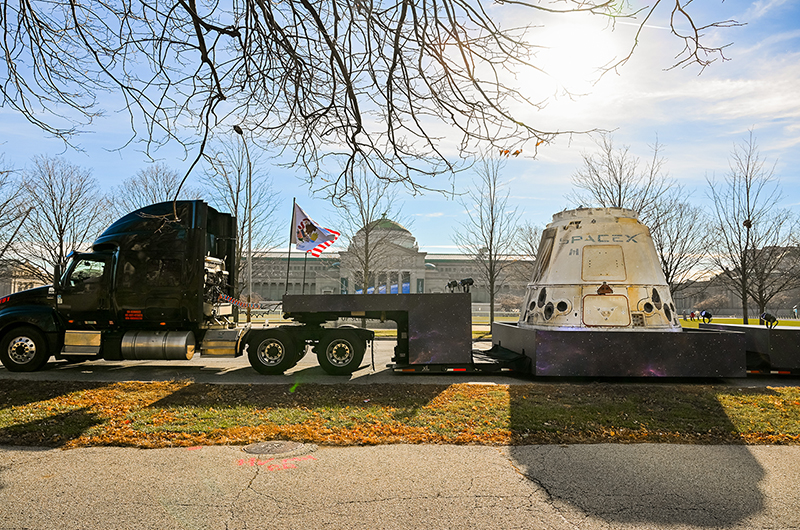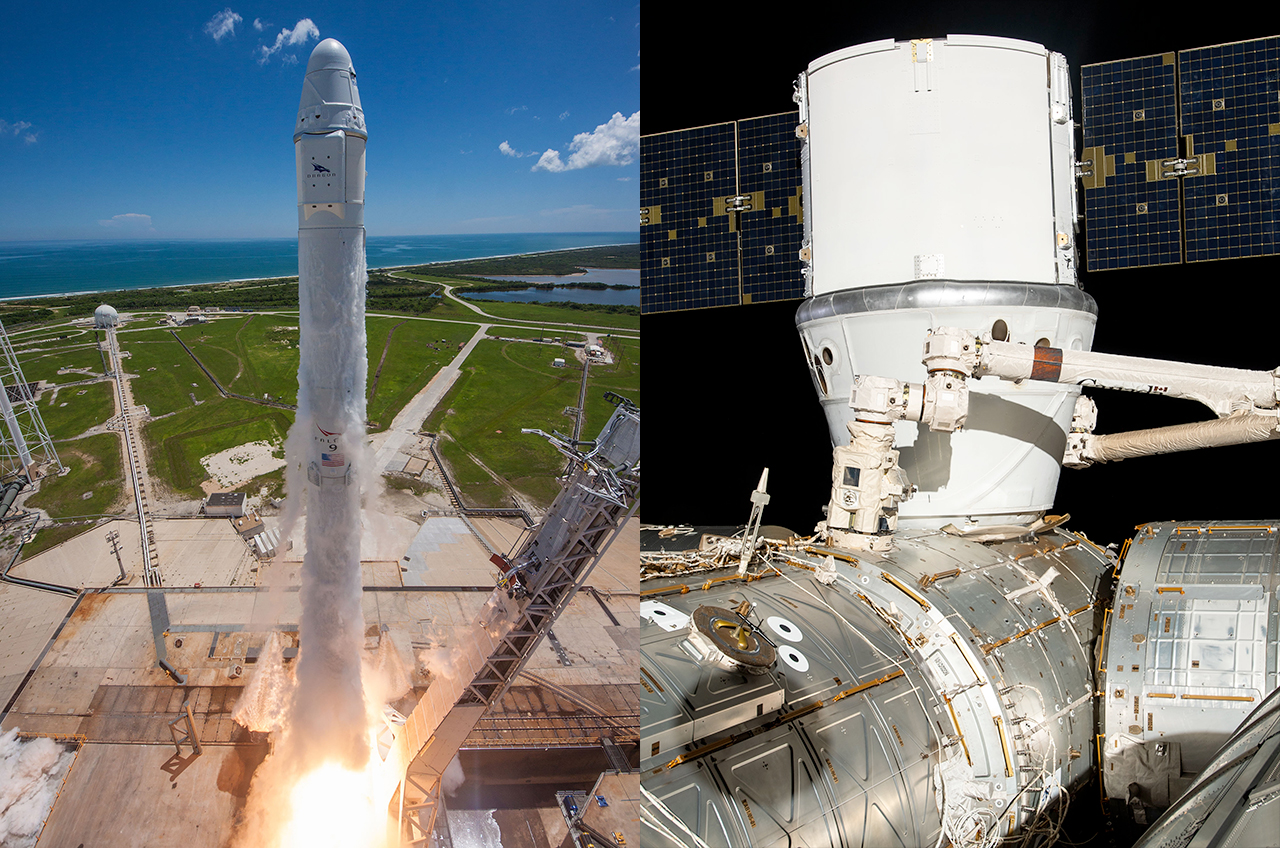SpaceX Dragon cargo spacecraft lands at Chicago museum ahead of exhibit
The twice-flown Dragon is set to go on permanent display in the spring of 2023.

A SpaceX Dragon spacecraft that twice splashed down has now landed for its last time — in Chicago.
The capsule, which flew two uncrewed missions to deliver cargo to and from the International Space Station, arrived at the Museum of Science and Industry (MSI) in Illinois on Thursday (Dec. 1) for its permanent exhibit. The Dragon will join other historic spacecraft in the museum's Henry Crown Space Center when it debuts on public display in the spring of 2023.
"On behalf of the MSI community I want to express my deep gratitude for this gift from SpaceX," Chevy Humphrey, president and chief executive officer of the Museum of Science and Industry, said on Thursday during a ceremony celebrating the capsule's delivery. "The SpaceX spacecraft will undoubtedly spark the curiosity and creativity of future engineers, makers, scientists and those who will create the sustainable solutions that propel us forward."
"I can't wait for the permanent exhibition to open," said Humphrey.

The Dragon joining the MSI collection, which SpaceX had assigned the serial number C113, was the 13th and last first-generation cargo capsule produced by the company. Of the same design as the Dragon that became the world's first commercial spacecraft to orbit Earth and be recovered intact, C113 flew to the International Space Station twice.
On its first Commercial Resupply Services (CRS) flight for NASA in August 2017, C113 lifted off on the CRS-12 mission carrying more than 6,400 pounds (2,900 kilograms) of science equipment and crew supplies for the station's Expedition 52 astronauts, including the Cosmic-Ray Energetics and Mass (CREAM) science instrument that was mounted on the exterior of the complex. The Dragon returned to Earth after 31 days and six hours in space.
C113 rode again atop a SpaceX Falcon 9 rocket in May 2019, on the CRS-17 mission for NASA. The Dragon launched with 5,500 pounds (2,500 kg) of cargo for the space station's Expedition 59 crew, including the Orbiting Carbon Observatory 3 and STP-H6 (Space Test Program-Houston 6), the latter a communications demo using beams of modulated X-rays. The capsule splashed down after 27 days and 23 hours off of Earth.
Get the Space.com Newsletter
Breaking space news, the latest updates on rocket launches, skywatching events and more!
In total, the Dragon logged 64 days, 12 hours and 4 minutes on its two missions.

SpaceX retired the first-generation Dragon spacecraft in 2020, replacing them with a more advanced model that was capable of flying both cargo and astronauts.
"This Dragon spacecraft very much embodies an exciting future for MSI, for the South Side, for our city and, yes, for space exploration as a whole as we look to more lunar and Mars manned missions," said Samir Mayekar, Deputy Mayor of Chicago. "To have this at our fingertips for all of us Chicagoans and our visitors, it is going to inspire us for our next chapter in terms of us being a 'city of stories.'"
MSI is the third venue to display a first-generation Dragon capsule. The very first Dragon to fly, C101, today hangs from the ceiling at SpaceX's headquarters in Hawthorne, California. The first Dragon to berth at the International Space Station, C102, is among the flown exhibits in Gateway: The Deep Space Complex at the Kennedy Space Center Visitor Complex in Florida.
The Henry Crown Space Center pays tribute to the "dreams and drama of space exploration ... with mission-flown spacecraft alongside stories and interactives recounting the missions that led us into space, and previewing the ones that will take us to Mars and beyond." The museum is home to Scott Carpenter's Mercury capsule, "Aurora 7," and the Apollo 8 command module, which carried the first humans to orbit the moon.
Follow collectSPACE.com on Facebook and on Twitter at @collectSPACE. Copyright 2022 collectSPACE.com. All rights reserved.
Join our Space Forums to keep talking space on the latest missions, night sky and more! And if you have a news tip, correction or comment, let us know at: community@space.com.

Robert Pearlman is a space historian, journalist and the founder and editor of collectSPACE.com, a daily news publication and community devoted to space history with a particular focus on how and where space exploration intersects with pop culture. Pearlman is also a contributing writer for Space.com and co-author of "Space Stations: The Art, Science, and Reality of Working in Space” published by Smithsonian Books in 2018.In 2009, he was inducted into the U.S. Space Camp Hall of Fame in Huntsville, Alabama. In 2021, he was honored by the American Astronautical Society with the Ordway Award for Sustained Excellence in Spaceflight History. In 2023, the National Space Club Florida Committee recognized Pearlman with the Kolcum News and Communications Award for excellence in telling the space story along the Space Coast and throughout the world.
-
Ed Marineves The Museum of Science and Industry (MSI) is one of the world's great treasures, and I'm so happy to hear the capsule will be joining its collection. An awful lot of people will be gazing at it with their imaginations on fire, and dreaming of the future.Reply










